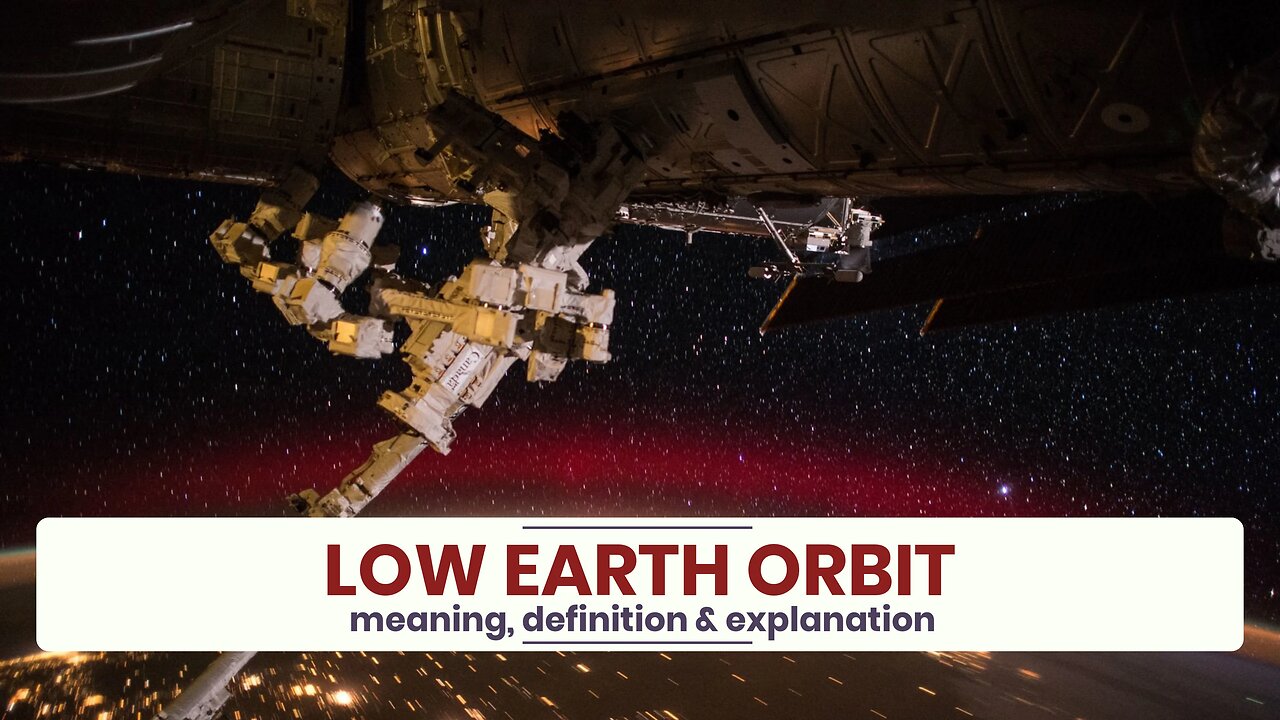Premium Only Content

What is LOW EARTH ORBIT?
✪✪✪✪✪
http://www.theaudiopedia.com
✪✪✪✪✪
What does LOW EARTH ORBIT mean? LOW EARTH ORBIT meaning - LOW EARTH ORBIT definition - LOW EARTH ORBIT explanation. What is the meaning of LOW EARTH ORBIT? What is the definition of LOW EARTH ORBIT? What does LOW EARTH ORBIT stand for? What is LOW EARTH ORBIT meaning? What is LOW EARTH ORBIT definition?
A low Earth orbit (LEO) is an orbit around Earth with an altitude between 160 kilometers (99 mi) (orbital period of about 88 minutes), and 2,000 kilometers (1,200 mi) (about 127 minutes). Objects below approximately 160 kilometers (99 mi) will experience very rapid orbital decay and altitude loss. The orbital velocity needed to maintain a stable low Earth orbit is about 7.8 km/s, but reduces with increased orbital altitude.
With the exception of the manned lunar flights of the Apollo program, all human spaceflights have taken place in LEO (or were suborbital). The International Space Station conducts operations in LEO. The altitude record for a human spaceflight in LEO was Gemini 11 with an apogee of 1,374.1 kilometers (853.8 mi). All manned space stations to date, as well as the majority of satellites, have been in LEO.
Objects in LEO encounter atmospheric drag from gases in the thermosphere (approximately 80–500 km up) or exosphere (approximately 500 km and up), depending on orbit height. Due to atmospheric drag, satellites do not usually orbit below 300 km. Objects in LEO orbit Earth between the denser part of the atmosphere and below the inner Van Allen radiation belt.
The orbital velocity needed to maintain a stable low Earth orbit is about 7.8 km/s, but reduces with increased orbital altitude. Calculated for circular orbit of 200 km it is 7.79 km/s and for 1500 km it is 7.12 km/s. The delta-v needed to achieve low Earth orbit starts around 9.4 km/s. Atmospheric and gravity drag associated with launch typically adds 1.3–1.8 km/s to the launch vehicle delta-v required to reach normal LEO orbital velocity of around 7.8 km/s (28,080 km/h).
Equatorial low Earth orbits (ELEO) are a subset of LEO. These orbits, with low inclination to the Equator, allow rapid revisit times and have the lowest delta-v requirement (i.e., fuel spend) of any orbit. Orbits with a high inclination angle to the equator are usually called polar orbits.
Higher orbits include medium Earth orbit (MEO), sometimes called intermediate circular orbit (ICO), and further above, geostationary orbit (GEO). Orbits higher than low orbit can lead to early failure of electronic components due to intense radiation and charge accumulation.
Although the Earth's pull due to gravity in LEO is not much less than on the surface of the Earth, people and objects in orbit experience weightlessness because they are in free fall.
A low Earth orbit is simplest and cheapest for satellite placement. It provides high bandwidth and low communication time lag (latency), but satellites in LEO will not be visible from any given point on the Earth at all times.
-
 1:52
1:52
The Audiopedia
9 months agoWhat is EXECUTIVE DIRECTOR?
531 -
 3:58:27
3:58:27
fuzzypickles168
10 hours agoLate Nite Jam Session - Rock Band 4 | Was: EA Sports WRC | 1 John 2:1-17
35.1K -
![Nintendo Switch It UP Saturdays with The Fellas: LIVE - Episode #13 [Mario Kart 8 Deluxe]](https://1a-1791.com/video/fww1/97/s8/1/1/g/A/z/1gAzy.0kob-small-Nintendo-Switch-It-UP-Satur.jpg) 3:33:38
3:33:38
MoFio23!
20 hours agoNintendo Switch It UP Saturdays with The Fellas: LIVE - Episode #13 [Mario Kart 8 Deluxe]
69.1K2 -
 23:24
23:24
MYLUNCHBREAK CHANNEL PAGE
21 hours agoDams Destroyed Turkey
113K97 -
 7:24:43
7:24:43
SpartanTheDogg
13 hours agoPro Halo Player
72.1K1 -
 11:29
11:29
Tundra Tactical
13 hours ago $3.86 earnedGEN Z Brit 3D Prints a WORKING Gun Pt.3!
67K6 -
 8:07:55
8:07:55
AdmiralSmoothrod
15 hours agoark ascended - its dino time again
41.7K2 -
 2:08:21
2:08:21
The Illusion of Consensus
9 days agoFormer FDA Official Dr. Philip Krause On White House Pressure To Approve Covid Vaccines at the FDA
76.6K99 -
![[Sabatoge Saturday] Monster Hunter Wilds - w/ Dio!! [crashed at end]](https://1a-1791.com/video/fww1/9d/s8/1/5/g/F/z/5gFzy.0kob-small-Sabatoge-Saturday-Monster-H.jpg) 7:32:40
7:32:40
CHiLi XDD
14 hours ago[Sabatoge Saturday] Monster Hunter Wilds - w/ Dio!! [crashed at end]
28.5K6 -
 8:34:09
8:34:09
RyuMuramasa✧
13 hours agoBlade of Vengeance | The First Berserker: Khazan | LIVE Playthrough!
25.8K